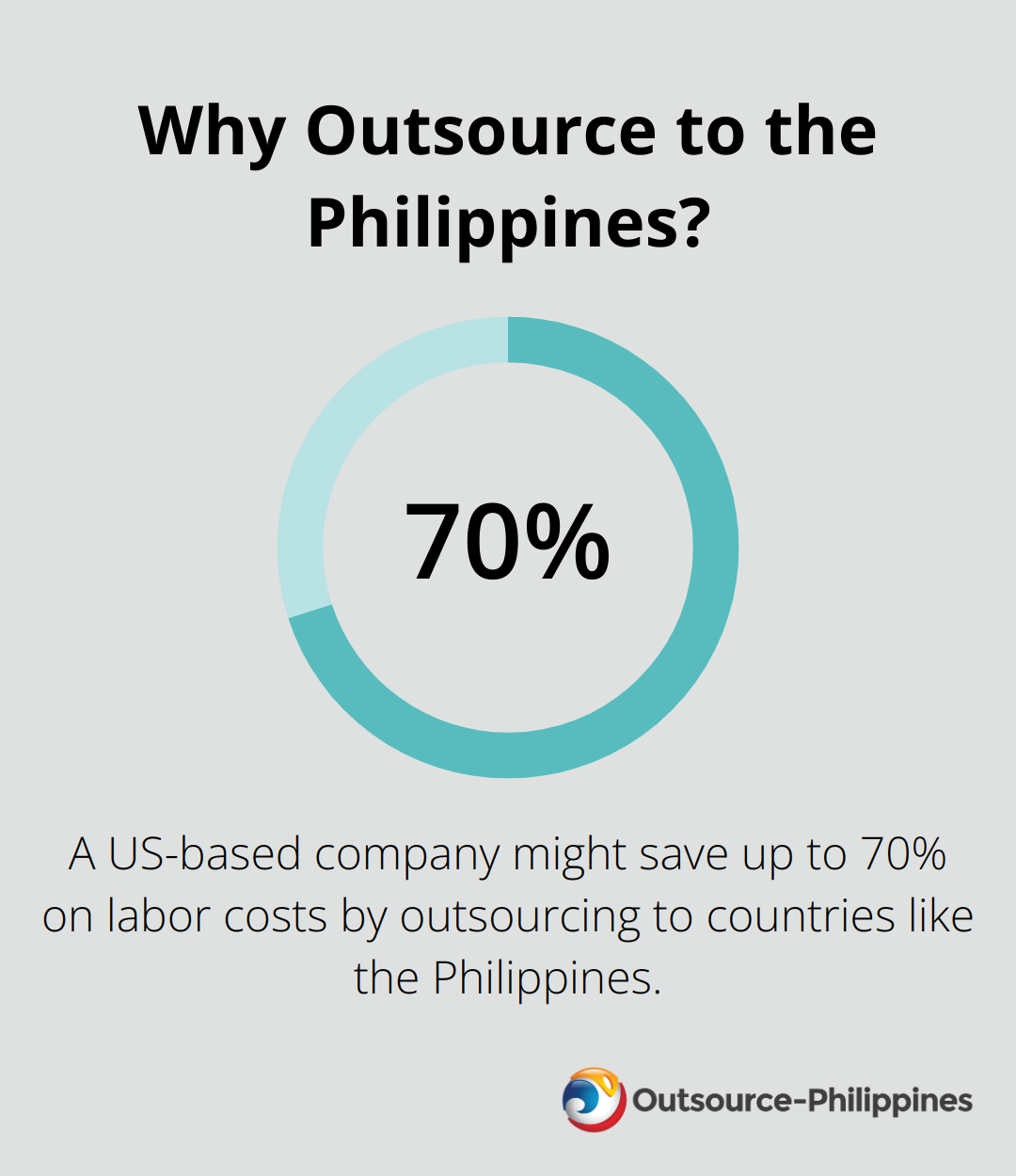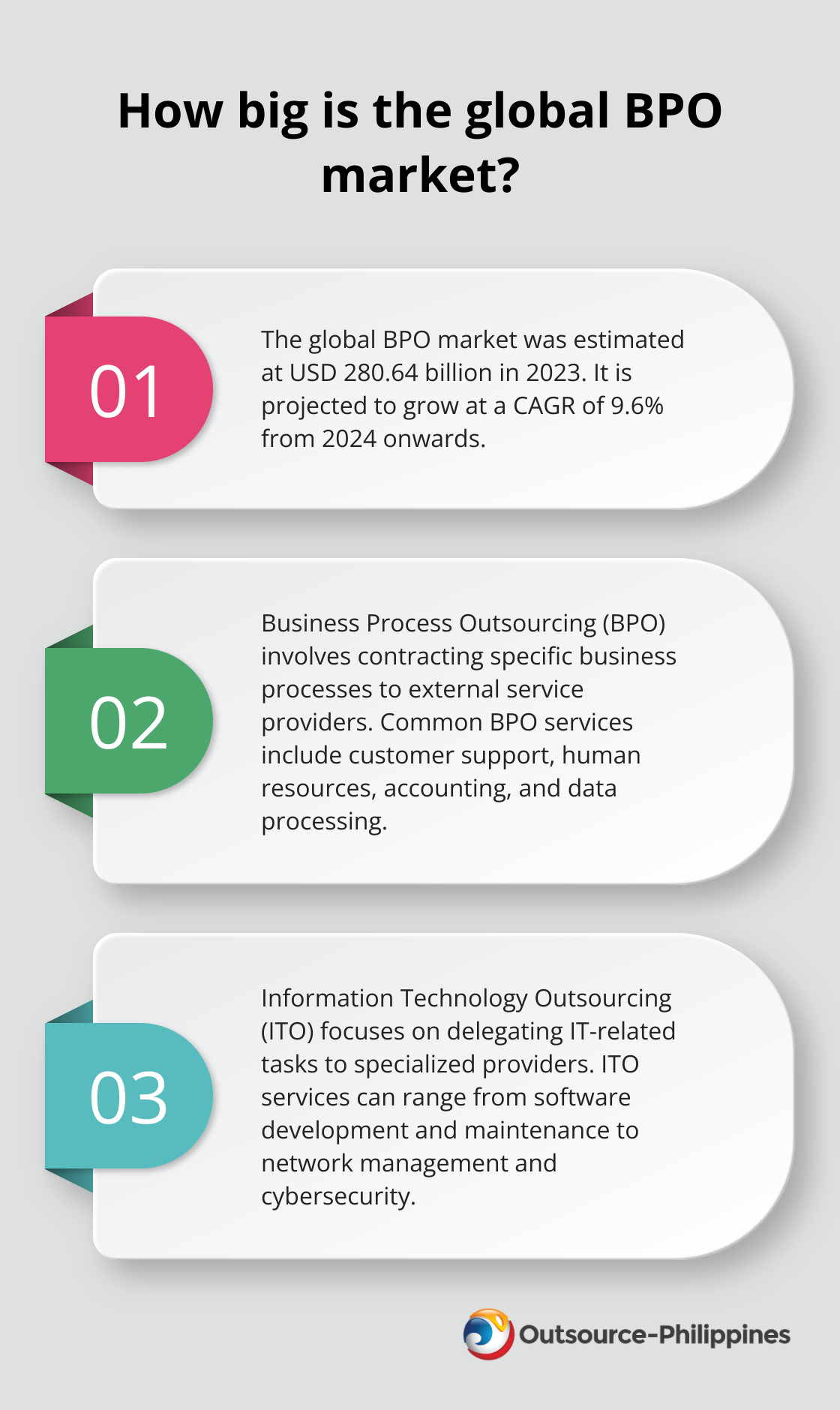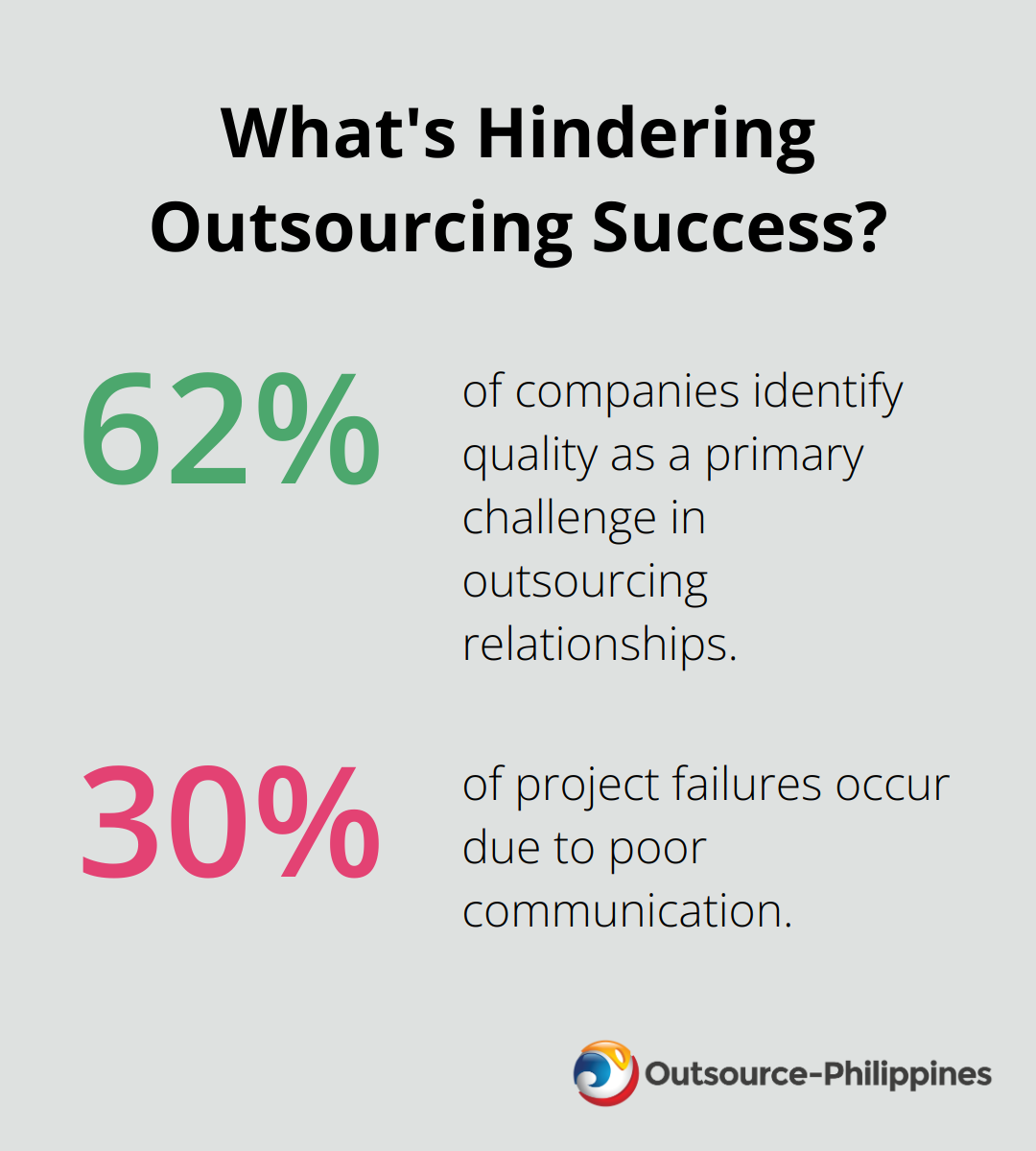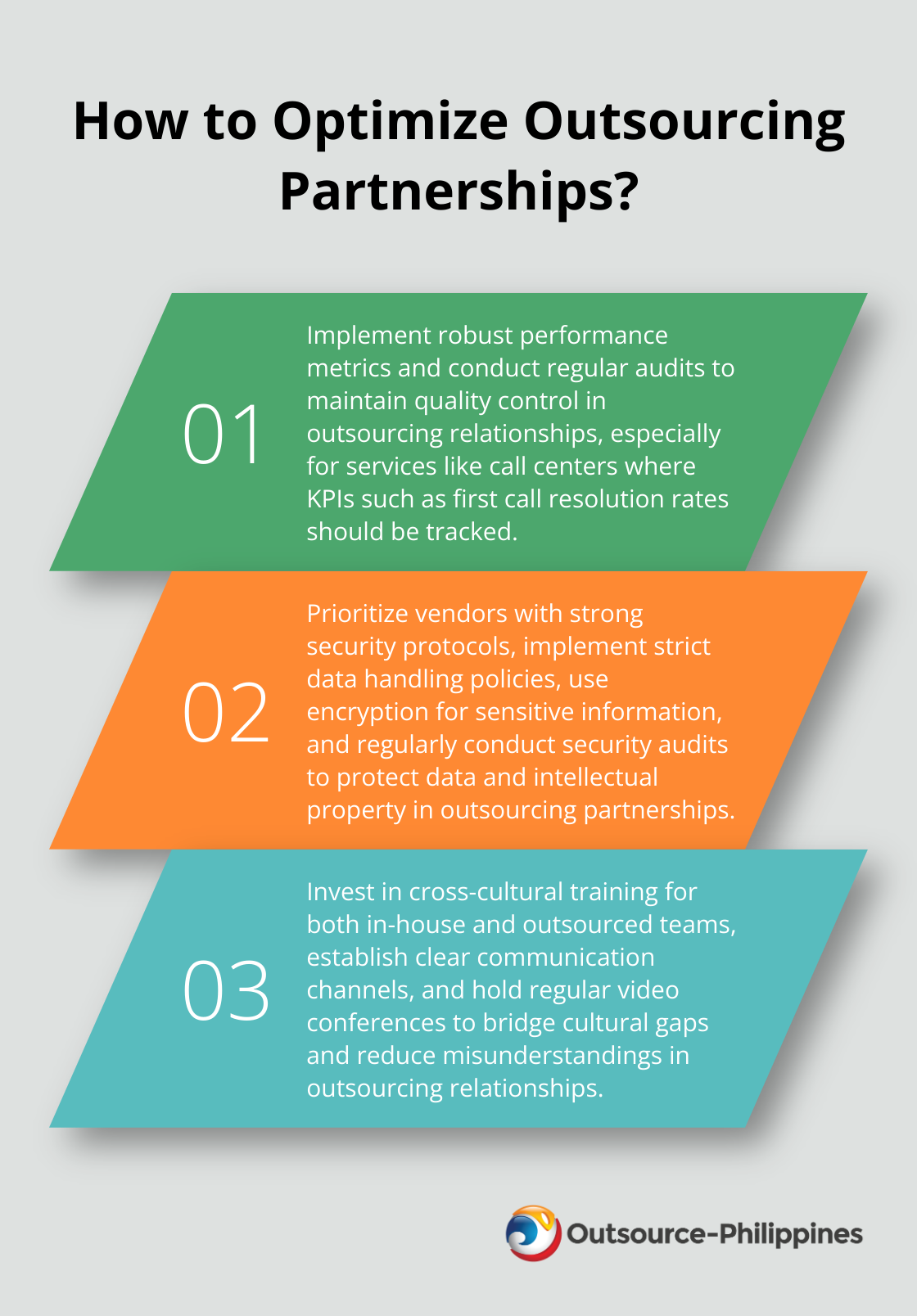Organizations are constantly seeking ways to optimize their operations and stay competitive. At Outsource Philippines, we’ve seen firsthand why organizations outsource and the transformative impact it can have on businesses.
This comprehensive analysis will explore the key drivers behind outsourcing decisions, common models and services, and the challenges companies face when partnering with external providers.
Why Do Organizations Choose to Outsource?
Organizations outsource for several compelling reasons. Let’s explore the key drivers that push businesses to embrace outsourcing strategies.
Cutting Costs Without Compromising Quality
Cost reduction remains a primary reason for outsourcing. Deloitte’s 2020 Global Outsourcing Survey reveals a sharp increase in the number of organizations giving priority to cost reduction. Partnerships with external providers allow businesses to significantly lower operational expenses, particularly in areas like labor costs, infrastructure, and technology investments.

A US-based company might save up to 70% on labor costs by outsourcing to countries like the Philippines (where skilled professionals are available at more competitive rates). This financial flexibility allows organizations to reallocate resources to core business activities or invest in growth initiatives.
Tapping into Global Talent Pools
Access to specialized skills and expertise is another major factor that drives outsourcing decisions. In today’s rapidly evolving business landscape, companies must stay competitive, which often requires niche skills that may not be readily available in-house or within local talent pools.
The IT Outsourcing market in the United States is projected to grow by 8.03% (2024-2029), resulting in a market volume of US$290.30bn in 2029. This trend extends beyond IT, with businesses seeking specialized talent in areas such as digital marketing, data analytics, and creative design.
Laser Focus on Core Competencies
Outsourcing non-core functions allows organizations to concentrate on their primary business objectives. The delegation of peripheral tasks to external experts enables companies to channel their energy and resources into activities that directly contribute to their competitive advantage.
A retail company might outsource its customer service operations to focus on product development and marketing strategies. This strategic approach not only improves efficiency but also enhances overall business performance.
Adapting to Market Demands
Scalability and operational flexibility are increasingly important in today’s dynamic business environment. Outsourcing provides organizations with the agility to quickly scale operations up or down based on market demands or seasonal fluctuations.
This flexibility is particularly valuable for startups and small businesses that need to manage resources efficiently while positioning themselves for growth.
Mitigating Risks and Ensuring Continuity
Outsourcing can help organizations mitigate risks associated with business continuity. By distributing operations across different locations (and potentially time zones), companies can ensure 24/7 service availability and reduce the impact of local disruptions.
For instance, a company that outsources its IT support to multiple locations can maintain continuous operations even if one location experiences technical difficulties or natural disasters. This risk mitigation strategy is especially important in today’s interconnected global economy.
As we explore these compelling reasons for outsourcing, it’s clear that this strategy offers numerous benefits for organizations of all sizes. However, to fully leverage these advantages, businesses must carefully consider various outsourcing models and services available in the market. Let’s examine these options in the next section.
Outsourcing Models Explained: Choosing the Right Approach
The world of outsourcing offers various models and services to cater to different business needs. Understanding these options helps organizations make informed decisions that align with their goals and objectives.
Business Process Outsourcing (BPO)
BPO involves the contracting of specific business processes to external service providers. This model has gained significant traction, with the global BPO market estimated at USD 280.64 billion in 2023 and projected to grow at a CAGR of 9.6% from 2024 onwards. Common BPO services include:
- Customer support
- Human resources
- Accounting
- Data processing
Many companies leverage 24/7 customer support to maintain high customer satisfaction levels while reducing operational costs.
Information Technology Outsourcing (ITO)
ITO focuses on the delegation of IT-related tasks to specialized providers. This can range from software development and maintenance to network management and cybersecurity. Informational technology security is costly in-house, so outsourcing cloud security services has become a prominent trend and is driving market growth.

Website design and management is a popular ITO service. Businesses often seek comprehensive management solutions that address security, performance, and user experience concerns.
Knowledge Process Outsourcing (KPO)
KPO involves the outsourcing of core business activities that are information-related. This model requires providers with advanced analytical and technical skills. Services often include:
- Market research
- Data analytics
- Legal processes
An increasing demand exists for data annotation services. Tech-driven sectors rely on precise data labeling for cleaner datasets, which is essential for machine learning and AI applications.
Geographic Outsourcing Models
Outsourcing can also be categorized based on the geographic location of the service provider:
- Offshore Outsourcing: This involves partnerships with providers in distant countries (often with significant time zone differences). The Philippines is a popular offshore destination, offering up to 70% cost savings for US companies.
- Nearshore Outsourcing: This model involves outsourcing to neighboring countries. For instance, US companies might outsource to Mexico or Canada.
- Onshore Outsourcing: Also known as domestic outsourcing, this involves the contracting of services within the same country.
Each model has its advantages, and the choice often depends on factors like cost, time zone compatibility, and cultural alignment.
The selection of the right outsourcing model and service is critical for maximizing the benefits of this strategy. It’s essential to align your choice with your business objectives, budget constraints, and operational requirements. While these models offer numerous advantages, organizations must also consider potential challenges and risks associated with outsourcing. Let’s explore these aspects in the next section.
Navigating Outsourcing Challenges
Quality Control in Outsourcing
Quality control remains a top concern when organizations outsource. A Deloitte study found that 62% of companies identify quality as a primary challenge in outsourcing relationships. To address this issue, organizations must implement robust performance metrics and conduct regular audits. For example, call center outsourcing requires tracking of key performance indicators (KPIs) such as first call resolution rates and customer satisfaction scores. Regular training sessions and clear communication of expectations prove crucial for maintaining high standards.
Data Security and Intellectual Property Protection
The protection of sensitive information and intellectual property is critical in outsourcing partnerships. The 2021 Data Breach Investigations Report by Verizon analyzed 29,207 quality incidents, of which 5,258 were confirmed breaches. To mitigate these risks, organizations should prioritize vendors with strong security protocols. The implementation of strict data handling policies, use of encryption for sensitive information, and regular security audits are essential steps. Non-disclosure agreements (NDAs) play a vital role in protecting intellectual property.
Overcoming Cultural Differences
Cultural gaps can lead to misunderstandings and inefficiencies in outsourcing relationships. A survey by the Project Management Institute showed that 30% of project failures occur due to poor communication. To bridge these gaps, organizations should invest in cross-cultural training for both in-house and outsourced teams. The establishment of clear communication channels and protocols is essential. Regular video conferences help build rapport and reduce misunderstandings. Organizations should consider working with outsourcing providers who have experience in bridging cultural gaps (such as Outsource Philippines).
Mitigating Vendor Dependencies
Over-reliance on external providers can pose risks to business continuity. To address this challenge, organizations must develop a comprehensive vendor management strategy. This strategy should include having backup providers, clear exit clauses in contracts, and knowledge transfer processes. Regular assessment of vendor performance and maintenance of some in-house expertise in outsourced areas ensures that organizations are not left vulnerable if a vendor relationship ends unexpectedly.
Effective Communication Strategies
Clear and consistent communication is key to successful outsourcing relationships. Organizations should establish multiple channels for communication (e.g., email, instant messaging, video calls) and set clear expectations for response times. Regular status meetings and progress reports help keep all parties aligned. The use of project management tools can facilitate transparency and collaboration. Organizations should also consider time zone differences when scheduling meetings and setting deadlines.

Maximizing the Benefits of Outsourcing
Organizations outsource for various reasons, including cost reduction, access to specialized skills, and increased operational flexibility. These benefits allow businesses to optimize their operations and maintain competitiveness in today’s fast-paced environment. However, companies must address potential challenges such as quality control, data security, and cultural differences to maximize the advantages of outsourcing.

The future of outsourcing will likely involve emerging technologies like artificial intelligence and automation, shaping new practices and opportunities. As businesses evolve, outsourcing relationships may shift towards more strategic, value-driven partnerships that extend beyond cost savings to drive innovation and competitive advantage. Companies that effectively leverage these trends can position themselves for long-term success in an increasingly global marketplace.
For organizations considering outsourcing, experienced providers like Outsource Philippines can offer valuable support in navigating the complexities of this strategy. Such partnerships can help businesses enhance their operational capabilities, focus on core growth areas, and adapt to changing market demands (while managing potential risks). As the business landscape continues to change, outsourcing remains a powerful tool for organizations looking to optimize their operations and achieve their strategic objectives.









